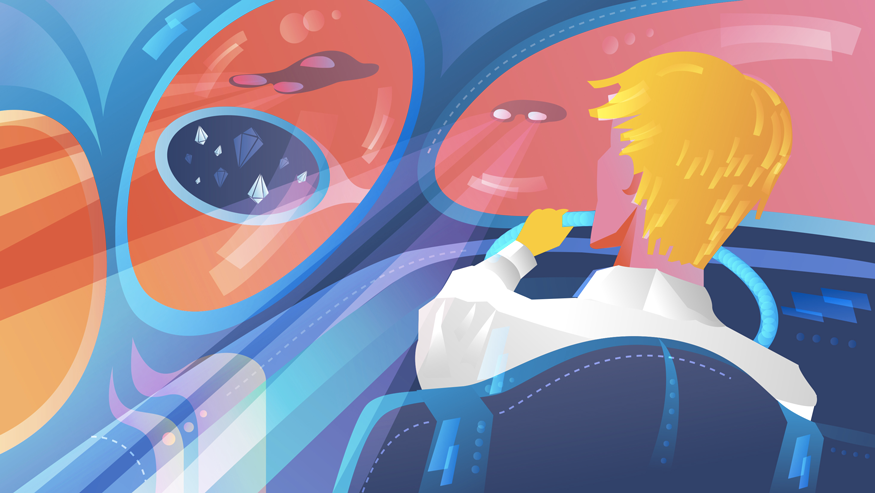Antimatter is the stuff of science fiction. In the book and film Angels and Demons, Professor Langdon tries to save Vatican City from an antimatter bomb. Star Trek’s starship Enterprise uses matter-antimatter annihilation propulsion for faster-than-light travel.
But antimatter is also the stuff of reality. Antimatter particles are almost identical to their matter counterparts except that they carry the opposite charge and spin. When antimatter meets matter, they immediately annihilate into energy.
While antimatter bombs and antimatter-powered spaceships are far-fetched, there are still many facts about antimatter that will tickle your brain cells.
1. Antimatter should have annihilated all of the matter in the universe after the big bang.
According to theory, the big bang should have created matter and antimatter in equal amounts. When matter and antimatter meet, they annihilate, leaving nothing but energy behind. So in principle, none of us should exist.
But we do. And as far as physicists can tell, it’s only because, in the end, there was one extra matter particle for every billion matter-antimatter pairs. Physicists are hard at work trying to explain this asymmetry.
2. Antimatter is closer to you than you think.
Small amounts of antimatter constantly rain down on the Earth in the form of cosmic rays, energetic particles from space. These antimatter particles reach our atmosphere at a rate ranging from less than one per square meter to more than 100 per square meter. Scientists have also seen evidence of antimatter production above thunderstorms.
But other antimatter sources are even closer to home. For example, bananas produce antimatter, releasing one positron—the antimatter equivalent of an electron—about every 75 minutes. This occurs because bananas contain a small amount of potassium-40, a naturally occurring isotope of potassium. As potassium-40 decays, it occasionally spits out a positron in the process.
Our bodies also contain potassium-40, which means positrons are being emitted from you, too. Antimatter annihilates immediately on contact with matter, so these antimatter particles are very short-lived.
3. Humans have created only a tiny amount of antimatter.
Antimatter-matter annihilations have the potential to release a huge amount of energy. A gram of antimatter could produce an explosion the size of a nuclear bomb. However, humans have produced only a minuscule amount of antimatter.
All of the antiprotons created at Fermilab’s Tevatron particle accelerator add up to only 15 nanograms. Those made at CERN amount to about 1 nanogram. At DESY in Germany, approximately 2 nanograms of positrons have been produced to date.
If all the antimatter ever made by humans were annihilated at once, the energy produced wouldn’t even be enough to boil a cup of tea.
The problem lies in the efficiency and cost of antimatter production and storage. Making 1 gram of antimatter would require approximately 25 million billion kilowatt-hours of energy and cost over a million billion dollars.
4. There is such a thing as an antimatter trap.
To study antimatter, you need to prevent it from annihilating with matter. Scientists have created ways to do just that.
Charged antimatter particles such as positrons and antiprotons can be held in devices called Penning traps. These are comparable to tiny accelerators. Inside, particles spiral around as the magnetic and electric fields keep them from colliding with the walls of the trap.
But Penning traps won’t work on neutral particles such as antihydrogen. Because they have no charge, these particles cannot be confined by electric fields. Instead, they are held in Ioffe traps, which work by creating a region of space where the magnetic field gets larger in all directions. The particle gets stuck in the area with the weakest magnetic field, much like a marble rolling around the bottom of a bowl.
Earth’s magnetic field can also act as a sort of antimatter trap. Antiprotons have been found in zones around the Earth called Van Allen radiation belts.
5. Antimatter might fall up.
Antimatter and matter particles have the same mass but differ in properties such as electric charge and spin. The Standard Model predicts that gravity should have the same effect on matter and antimatter; however, this has yet to be seen. Experiments such as AEGIS, ALPHA and GBAR are hard at work trying to find out.
Observing gravity’s effect on antimatter is not quite as easy as watching an apple fall from a tree. These experiments need to hold antimatter in a trap or slow it down by cooling it to temperatures just above absolute zero. And because gravity is the weakest of the fundamental forces, physicists must use neutral antimatter particles in these experiments to prevent interference by the more powerful electrical force.
Editor's note: In 2023, the ALPHA experiment published results indicating that antimatter does indeed fall down.
6. Antimatter is studied in particle decelerators.
You’ve heard of particle accelerators, but did you know there were also particle decelerators? CERN houses a machine called the Antiproton Decelerator, a storage ring that can capture and slow antiprotons to study their properties and behavior.
In circular particle accelerators like the Large Hadron Collider, particles get a kick of energy each time they complete a rotation. Decelerators work in reverse; instead of an energy boost, particles get a kick backward to slow their speeds.
7. Neutrinos might be their own antiparticles.
A matter particle and its antimatter partner carry opposite charges, making them easy to distinguish. Neutrinos, nearly massless particles that rarely interact with matter, have no charge. Scientists believe that they may be Majorana particles, a hypothetical class of particles that are their own antiparticles.
Projects such as the Majorana Demonstrator and EXO-200 are aimed at determining whether neutrinos are Majorana particles by looking for a behavior called neutrinoless double-beta decay.
Some radioactive nuclei simultaneously decay, releasing two electrons and two neutrinos. If neutrinos were their own antiparticles, they would annihilate each other in the aftermath of the double decay, and scientists would observe only electrons.
Finding Majorana neutrinos could help explain why antimatter-matter asymmetry exists. Physicists hypothesize that Majorana neutrinos can either be heavy or light. The light ones exist today, and the heavy ones would have only existed right after the big bang. These heavy Majorana neutrinos would have decayed asymmetrically, leading to the tiny matter excess that allowed our universe to exist.
8. Antimatter is used in medicine.
PET (positron emission tomography) uses positrons to produce high-resolution images of the body. Positron-emitting radioactive isotopes (like the ones found in bananas) are attached to chemical substances such as glucose that are used naturally by the body. These are injected into the bloodstream, where they are naturally broken down, releasing positrons that meet electrons in the body and annihilate. The annihilations produce gamma rays that are used to construct images.
Scientists on CERN’s ACE project have studied antimatter as a potential candidate for cancer therapy. Physicians have already discovered that they can target tumors with beams of particles that will release their energy only after safely passing through healthy tissue. Using antiprotons adds an extra burst of energy. The technique was found to be effective in hamster cells, but researchers have yet to conduct studies in human cells.
9. The antimatter that should have prevented us from existing might still be lurking in space.
One way that scientists are trying to solve the antimatter-matter asymmetry problem is by looking for antimatter left over from the big bang.
The Alpha Magnetic Spectrometer is a particle detector that sits atop the International Space Station searching for these particles. AMS contains magnetic fields that bend the path of cosmic particles to separate matter from antimatter. Its detectors assess and identify the particles as they pass through.
Cosmic ray collisions routinely produce positrons and antiprotons, but the probability of creating an antihelium atom is extremely low because of the huge amount of energy it would require. This means the observation of even a single antihelium nucleus would be strong evidence for the existence a large amount of antimatter somewhere else in the universe.
10. People are actually studying how to fuel spacecraft with antimatter.
Just a handful of antimatter can produce a huge amount of power, making it a popular fuel for futuristic vehicles in science fiction.
Antimatter rocket propulsion is hypothetically possible; the major limitation is gathering enough antimatter to make it happen.
There is currently no technology available to mass-produce or collect antimatter in the volume needed for this application. However, a small number of researchers have conducted simulation studies on propulsion and storage. These include Ronan Keane and Wei-Ming Zhang, who did their work at Western Reserve Academy and Kent State University, respectively, and Marc Weber and his colleagues at Washington State University. One day, if we can figure out a way to create or collect large amounts of antimatter, their studies might help antimatter-propelled interstellar travel become a reality.
For more antimatter facts, see Four (more) things you might not know about antimatter.

















